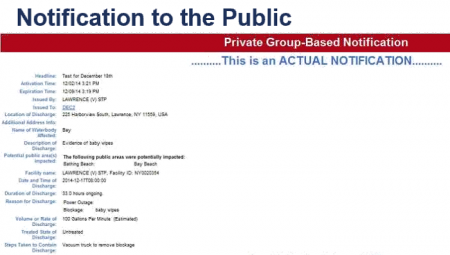Time to Sign Up for Sewage Right to Know Alerts

Example of a NY-Alert notification for a sewage release.
View more images on our Flickr site
The Department of Environmental Conservation (DEC) took one important step forward this month with the creation of the state’s first realtime notification system for sewage discharges affecting recreational water quality.
Discharges of untreated and partially treated sewage from publicly owned separate sewer systems and treatment plants will now be disclosed within four hours via the state’s NY-Alert system. (In reality, the state is still working to sign up all publicly owned sewage treatment plants and systems, so reporting is incomplete at present.) Riverkeeper urges the public and the press to sign up to receive these customizable alerts via email, phone or text.
Visit users.nyalert.gov and watch this DEC video to learn how to register to receive alerts. The use of the NY-ALERT system, which also provides realtime alerts on topics ranging from extreme weather to road closures, and is customizable based on the preferences of each user, is a huge advance. But the process of signing up for these alerts is clunky, so it is well worth your time to watch the video as you learn to use the NY-Alert service.
The video is very useful for navigating the signup process, which is not simple. For those who don’t want to watch the video, try to follow these steps:
- Visit https://users.nyalert.gov/
- Choose “Add additional alerts”
- Choose “Customized Notification”
- Click “Environmental” and then Choose “Customize”
- Click “Environmental – Not Otherwise Categorized”
- Follow the prompts to choose how you want to receive alerts, and for what geographic regions.
Other sewage release notification services include:
- New York City residents may sign up to receive realtime CSO alerts via Notify NYC.
- The Capital District and Kingston notify the public when modeling or monitoring indicate CSOs are discharging.
Sewage Releases Threaten Public Health
The Sewage Pollution Right to Know Law was passed by the Legislature and signed by Gov. Andrew Cuomo in 2012. Riverkeeper led a coalition of organizations in drafting and advocating for passage of the law. During the recreational season in 2014 (April through September) 121 sewage treatment plants reported millions of gallons of sewage discharges in 823 separate discharges. We would not have known about most of these discharges, or any of hundreds others reported since the law took effect in May 2013, were it not for the Sewage Pollution Right to Know Law. Until now, with the advent of the NY-ALERT system, however, public notification of these discharges was available only on a spreadsheet downloadable from a DEC web page.
Human exposure to disease-causing pathogens contained in even small amounts of raw sewage can lead to short-term and chronic illnesses, especially for children, the elderly and people with compromised immune systems. Despite the fact that waterborne illnesses are underreported, the number of documented illnesses resulting from swimming is on the rise nationwide. The U.S. Environmental Protection Agency has estimated that between 1.8 and 3.5 million Americans become ill annually from contact with sewage in recreational waters.
Federal funding for wastewater infrastructure has declined dramatically in recent decades. This lack of funding has contributed to a significant decline in the maintenance and upgrades of New York’s wastewater infrastructure. More than 600 wastewater treatment facilities in New York are operating beyond their life expectancy and many others are using outmoded and inadequate technology that results in the discharge of hundreds of millions of gallons of untreated sewage into waters used by New Yorkers for recreation and, in some cases, drinking water.
Riverkeeper is advocating for new spending in the next state budget to start to fill the estimated $36 billion gap in needed funding for wastewater infrastructure–so sewage releases are less frequent, and public health is protected.
Sewage Pollution Right to Know Alerts Are Only A First Important Step
Users of the new NY-Alert system should be aware that not all pollution that may cause illness will be reported.
Riverkeeper monitors water quality in 74 locations in the Hudson River estuary between New York City and Waterford, and, in cooperation with dozens of citizen scientists, 149 waterfront and tributary locations. More than one in five of our samples in the Hudson River has failed to meet Environmental Protection Agency guidelines for safe swimming, and data gathered by citizen partners indicates a swimmer’s chance of encountering poor water quality is far greater in our creeks and streams, and along urban waterfronts.
Yet none, or nearly none, of these instances of contamination documented since the Sewage Pollution Right to Know Law took effect can be attributed to reported sewage releases.
Our goal is to provide the public with information about water quality – similar to weather forecasts – that is widely distributed by the media, and based on widespread data collection and modeling. You should know before you enter the water what the water quality is likely to be.
The Sewage Pollution Right to Know Law provides a new and valuable source of information about an important source of sewage contamination to our waters. But the absence of a recent sewage discharge report does not indicate that the water is safe for swimming or other recreation. There’s more work to be done.
